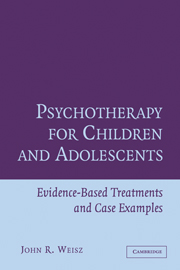Book contents
- Frontmatter
- Contents
- Preface
- SECTION A GENERAL INTRODUCTION
- SECTION B TREATMENTS FOR FEARS AND ANXIETY
- SECTION C TREATMENTS FOR DEPRESSION
- SECTION D TREATMENTS FOR ATTENTION DEFICIT/HYPERACTIVITY DISORDER
- SECTION E TREATMENTS FOR CONDUCT PROBLEMS AND CONDUCT DISORDER
- Introduction to Section E: The Case of Sal and Treatments for Conduct Problems and Conduct Disorder
- 8 Treating Conduct Problems by Teaching Anger Control
- 9 Behavioral Parent Training and Family Treatment for Conduct Problems
- 10 Parent-Child Interaction Treatments for Child Noncompliance
- 11 Parent Training through Video Modeling and Structured Group Discussion
- 12 Using Problem-Solving Skills Training and Parent Management Training for Children with Conduct Disorder
- 13 Multisystemic Therapy for Antisocial and Delinquent Youth
- SECTION F CONCLUSION
- References
- Author Index
- Subject Index
10 - Parent-Child Interaction Treatments for Child Noncompliance
Published online by Cambridge University Press: 06 July 2010
- Frontmatter
- Contents
- Preface
- SECTION A GENERAL INTRODUCTION
- SECTION B TREATMENTS FOR FEARS AND ANXIETY
- SECTION C TREATMENTS FOR DEPRESSION
- SECTION D TREATMENTS FOR ATTENTION DEFICIT/HYPERACTIVITY DISORDER
- SECTION E TREATMENTS FOR CONDUCT PROBLEMS AND CONDUCT DISORDER
- Introduction to Section E: The Case of Sal and Treatments for Conduct Problems and Conduct Disorder
- 8 Treating Conduct Problems by Teaching Anger Control
- 9 Behavioral Parent Training and Family Treatment for Conduct Problems
- 10 Parent-Child Interaction Treatments for Child Noncompliance
- 11 Parent Training through Video Modeling and Structured Group Discussion
- 12 Using Problem-Solving Skills Training and Parent Management Training for Children with Conduct Disorder
- 13 Multisystemic Therapy for Antisocial and Delinquent Youth
- SECTION F CONCLUSION
- References
- Author Index
- Subject Index
Summary
Most treatments addressing conduct problems in youth emphasize corrective action aimed at the offending behavior. In the most common of these approaches, therapists work with parents on discipline skills, trying to restructure contingencies so as to stop the undesirable behavior (see Chapters 8, 9, 11, and 12). Readers who are most familiar with traditional child therapy may wonder what has happened to the venerable tradition of working with the child through the medium of play, letting the child take the lead, commenting on the child's activity and building a positive relationship with the child (see e.g., Bromfield, 1992; Russ, 1998; Tuma & Sobotka, 1983). Some of these traditional elements do survive within the evidence-based treatments, but in a modified way, in a two-stage treatment approach based on the work of Hanf (1969, 1970; Hanf & Kling, 1974). The Hanf approach was originally developed for work with physically handicapped children, but applications soon evolved for use with noncompliance in general. A core assumption underlying the Hanf approach is that a parent's efforts to influence a child's behavior will gain potency in the context of a positive parent-child connection, partly because a positive relationship enhances the child's attentiveness to, and motivation to cooperate with, the parent.
In the Hanf model, the therapist works directly with the parent, serving as both teacher and coach, as the parent engages in a series of playlike interactions with the child. In the first phase of the process, labeled “Child's game” by Hanf, the child chooses the play activities; as the child takes the lead, the parent learns to attend closely, comment descriptively, and praise and reward the child liberally.
- Type
- Chapter
- Information
- Psychotherapy for Children and AdolescentsEvidence-Based Treatments and Case Examples, pp. 313 - 352Publisher: Cambridge University PressPrint publication year: 2004



